
 Image: IDG / Dominic Bayley
Image: IDG / Dominic Bayley
 At a glance
At a glance
Expert’s Rating
Pros
Excellent CPU and GPU performanceRobust and innovative designComfortable and customizable keyboard
Cons
Trackpad requires some pressureVery high price
Our Verdict
The Asus ROG Zephyrus S17 is a performance powerhouse that doesn’t shirk on providing everything you need to enhance your gaming experience.
Price When Reviewed
$2,200 (base unit) up to $3,700 (review unit)
Best Prices Today: Asus ROG Zephyrus S17
RetailerPriceAsus$3699.99View Deal
The latest Asus ROG Zephyrus S17 has just about everything you’d want in a gaming laptop. You can expect loads of power thanks to the powerful pairing of an 11th-generation Intel i9 processor and a Nvidia RTX 3080 GPU. A 17.3-inch 4K display with 120Hz refresh rate also adds to the premium experience, even if it’s not the pinnacle of 4K.
This laptop also spoils you with a robust metal chassis, six speaker sound system, and RGB per key-lit optical mechanical keyboard – features that any discerning gamer would find hard to resist. Admittedly, all this power and functionality doesn’t come cheap. But neither does a sports car or a tailor-made suit, two other premium items you might want to try at least once in your life.
Asus ROG Zephyrus S17 specifications
There are four configurations of the Asus ROG Zephyrus S17 on the Asus website, with prices starting at $2,199.99 for models with a i7-11800H processor. The prices rise consecutively for the three other units, which have Intel i9-11900H processors. The three cheaper units all come with WQHD (2560 x 1440) 165Hz displays with G-Sync and Advanced Optimus, and either 1TB or 2TB of SSD storage. The top tier configurations like the $3,699.99 ROG Zephyrus S17 (GX703HS-XB99) come with a 4K (3840 x 2160) 120Hz display with Adaptive-Sync, and 3 x 1TB SSD (RAID0) for storage. The specifications of our top-tier review unit are as follows:
CPU: Intel Core i9-11900H
RAM: 32GB DDR4/3200MHz
GPU: Nvidia GeForce RTX 3080
Display: 17.3-inch UHD (3840 x 2160), non-touch IPS-level panel, 120Hz refresh rate, DCI-P3 100%
Storage: 3 x 1TB PCle 4 SSD (RAID0)
Ports: Type-C USB with Thunderbolt 4 (DisplayPort 1.4, power delivery); USB 3.2 Gen2 Type-C (DisplayPort 1.4, power delivery); USB 3.2 Gen 2 Type-A, 2 x USB 3.2 Type-A; HDMI 2.0b, 3.5 mm Combo jack, Gigabit Ethernet, SD card slot.
Networking: Wi-Fi 6 (802.11ax 2×2), Bluetooth 5.0
Dimensions: 15.51 x 10.39 x 0.78 inches
Weight: 6.06 lbs (2.75 kg); the powerbrick weighs 1.9 lbs (0.9 kg)
Operating system: Windows 10 Home
Color: Matte Black
Battery capacity: 90WHr
Design and build
The 2020 edition Asus ROG Zephyrus S17 introduced an innovative gap in the lower case to provide extra cooling. It was somewhat of a science experiment by Asus and quite a brave move in a market where nothing like it existed before. From all accounts, the unique design was successful, providing the S17’s fans with extra air for cooling and allowing hot air to be vented out the back and sides.
Love it or hate it, that gap is back again in the latest Zephyrus S17, but more practical than before. I say practical because this feature had the unfortunate consequence of dictating where the keyboard had to go in the previous edition. It was placed towards the front periphery of the laptop and the trackpad was positioned on the right side of the keyboard, which isn’t ideal, especially if you’re left-handed.
The refreshed S17’s design now sees the case lift up 12 mm behind the keyboard when you open the lid, still affording extra air to the two Arc Flow fans, while the keyboard itself – now positioned more towards the back – lifts with it and moves towards you. The trackpad is out front where you’d expect it to be.
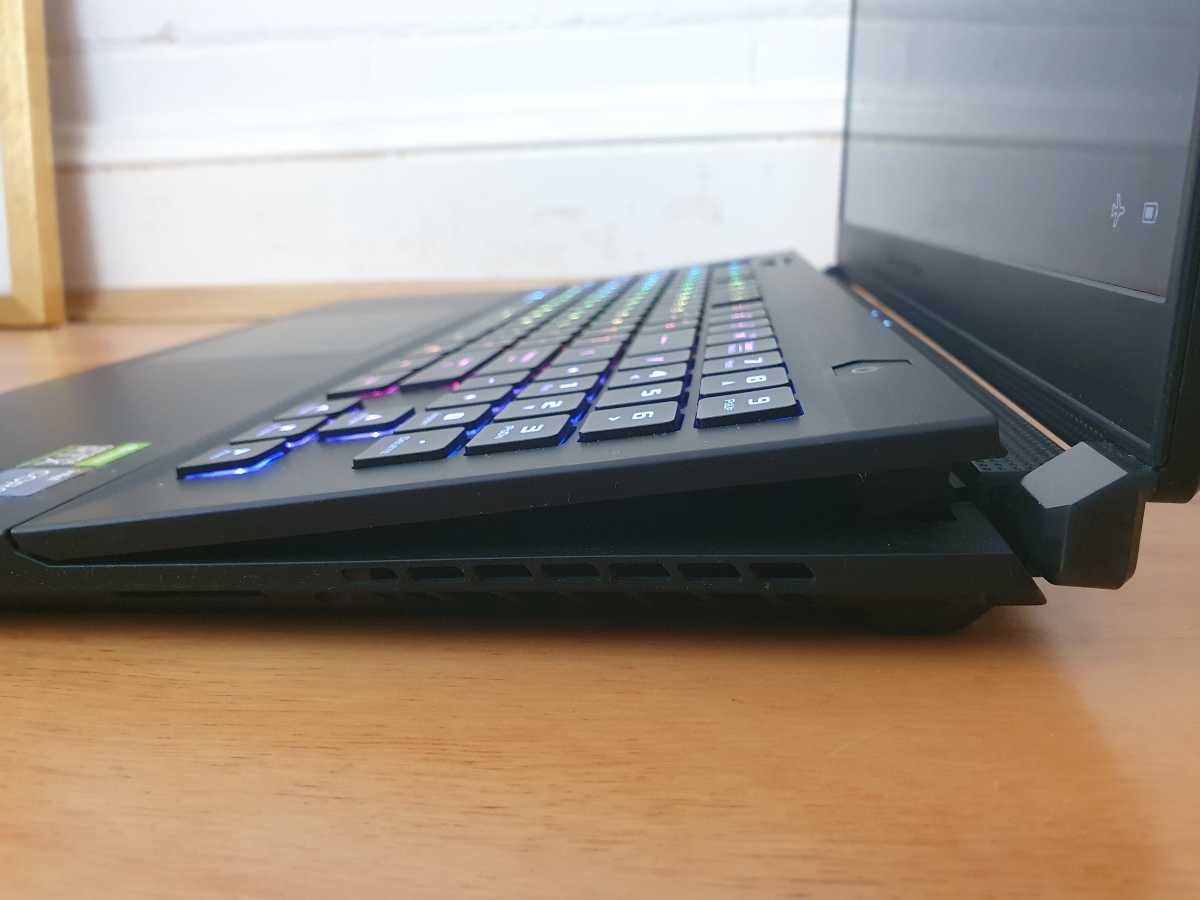
IDG / Dominic Bayley
IDG / Dominic Bayley
IDG / Dominic Bayley
This lifting keyboard mechanism happens very smoothly and is quite satisfying to watch before you begin gaming. Asus tells us the keyboard, although remarkably thin, can withstand repeated 12.5kg pressure testing without cracking. Judging by the S17’s all metal exterior and strong hinges, that’s very believable. That said, there’s a little give directly in the center of the keyboard underneath the 4K panel.
In the size department, the S17 is quite big, measuring 15.51 x 10.39 x 0.78 inches. It takes up a good portion of any tabletop, so you’ll need sizeable one. But being large is the very point of the S17. All that size is perfect to house its 17.3-inch display that comes cradled by thin bezels to its left and right edges that make up an 88 percent screen-to-body ratio. The lower bezel is slightly thicker, showing off the words “ROG Zephyrus.”
Despite its impressive size, the overall aesthetic of the S17 is understated. It sports a clean matte black magnesium-aluminum chassis. The muted black contrasts nicely with the colored RGB keys from the optical mechanical keyboard – all the styling I’d need. However, on top of the lid, there’s also a subtle dot pattern and ROG branding, which adds to the visual appeal.

Asus
Asus
Asus
As you would expect in a large gaming laptop, the S17 isn’t light to carry. It weighs 6.06 lbs, which is slightly more than a close competitor, the Gigabyte Aero 17 (5.5 lbs).
Keyboard and touchpad
Some gaming laptops go all out in the CPU and GPU stakes while offering a more modest keyboard, but not the S17. This laptop sports an optical mechanical keyboard with per key illumination.
Typing on the keyboard is extremely comfortable. It’s the kind of comfort that allows you to just zone out and play without worrying about niggling key issues. The keyboard’s big size lets your hands relax into a wide typing posture and the generous-sized palm rests provide a lot of support even for larger hands. My comfort was enhanced by the 5-degree tilt that gently angled my hands upwards like at a desktop.
The keys are highly tactile and the mechanical switches respond quickly, registering loud clicks with each of your keystrokes. Travel is 1.9mm, which is quite adequate. The keyboard just has a deceptively low profile. It also stays cool to the touch even after 30 minutes of gaming, one of the benefits of the increased airflow beneath it.
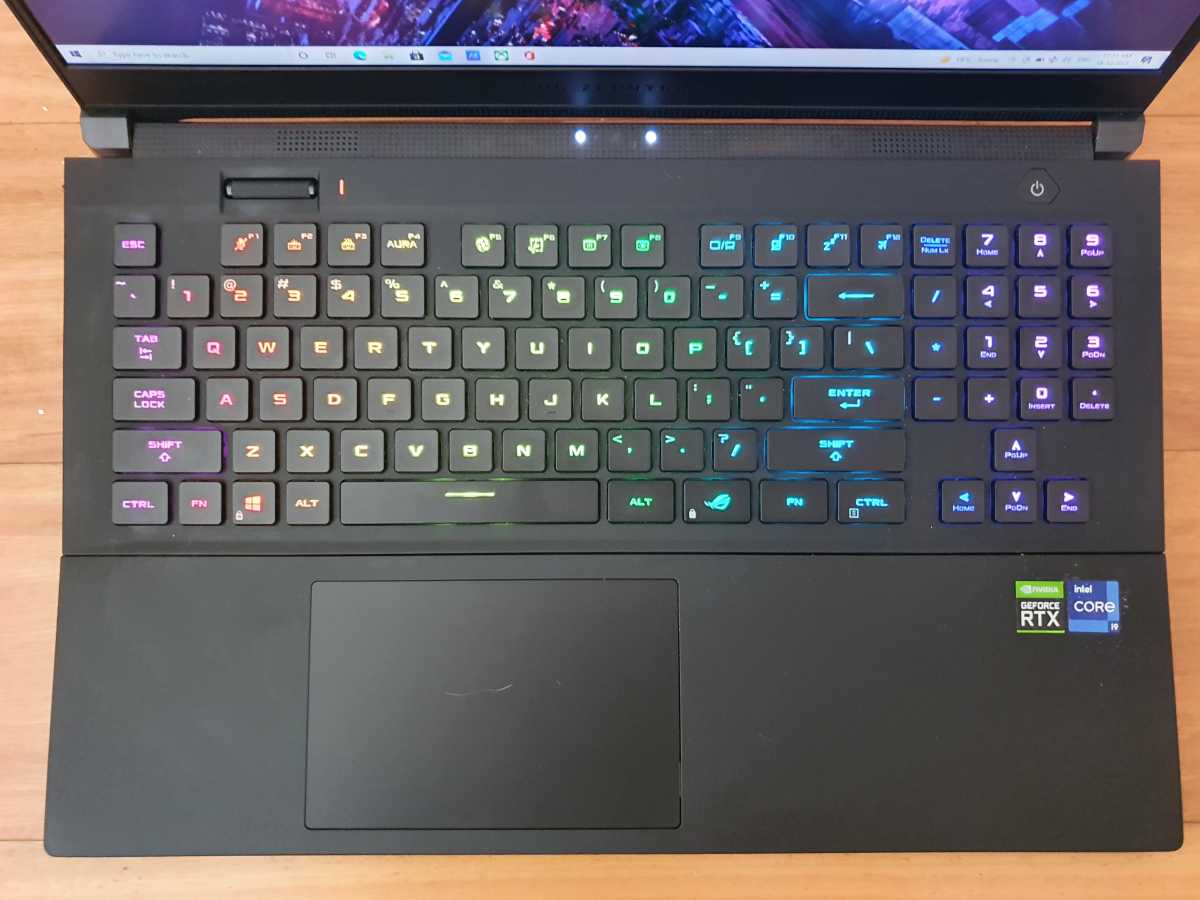
IDG / Dominic Bayley
IDG / Dominic Bayley
IDG / Dominic Bayley
Although the entire keyboard and trackpad is leagues ahead of the 2020 edition’s unusual layout, it may still not please everyone. It features a reduced numpad, which means some keys like the 0 and + are quite small. You also won’t see an Enter key on the far right hand side.
That said, the trade-off is full-sized keys to the left of the numpad. The arrow keys on the right are full-sized, too. For the latter, Asus has opted not to position them off the lower periphery of the keyboard. This means they line up nicely and aren’t too conspicuous.
Having the power to individually illuminate selected keys seemed at first a trifle extravagant. But I soon found this feature invaluable for assigning hotkeys for games like Age of Empires 4. Asus has given us the option to go all out with key personalization, or just select from a number of presets in the S17’s official software hub, Armory Crate.
The centrally located touchpad is less impressive than the keyboard. While it does the job, clicks are a bit loud and require more pressure than I would have expected from a gaming touchpad where speed is of the essence. The surface could also have benefited from being smoother. Still, it’s positioning out front is a marked improvement year on year.
Display and webcam
The Zephyrus S17’s 4K display has decent contrast and color, but in my view both these attributes could have been slightly better considering the panel’s high resolution. Some images appeared just above average’ for these traits when I was expecting to be blown away.
The panel is extremely bright at 516 nits peak brightness (by our Lux meter), making it easily visible even in glaring daylight conditions. There was no visible color bleed, although this has been known to vary somewhat from panel to panel in different laptops of the same model.
As for smoothness, our 4K display’s 120Hz refresh rate appeared to eliminate most visible micro-stuttering in both video and AAA games. There was also no observable tearing, likely thanks to the Adaptive Sync in our model, a feature not present in cheaper configurations.
The 720p HD camera produces adequate pictures that were neither too grainy or dark.
Audio
Audio-wise, the ROG Zephyrus S17 is somewhat of an anomaly among laptops in that it produces a rich multi-layered sound that’s equally good plugged in or unplugged.
With the sound up, you can really hear (and feel) the deep bass notes hitting their mark. They also sound clear and unmuffled. The S17’s sound system consists of 6 speakers. Four tweeters are located underneath the keyboard while the two woofers sit below the display. This setup produces the classic “soundscape experience” you often read about in product descriptions for portable speakers where the sound appears to come at you from different directions.
On the left side above the keyboard sits a wheel that allows you to control the volume by simply scrolling it up and down. I found I could get the exact volume setting I wanted in much less time using this than the obligatory laptop volume keys.
Connectivity
The Zephyrus has a generous array of modern ports, making it equally useful for gaming as well as content creation. There are two port options to connect to extra displays, including a USB-C and a Thunderbolt 4 port.

Asus
Asus
Asus
The latter lets you hook up dual 4K displays or one 8K display and enjoy the fastest data transfer speeds. On the left, you’ll also find a HDMI 2.0b port. A Gigabit Ethernet port allows you to get the fastest connection speeds in online games while the Wi-Fi 6 support provides decent speeds for when you’re unplugged.

Asus
Asus
Asus
Performance
The Asus ROG Zephyrus S17’s large, slab-like chassis isn’t wasted on middling power. With its combination of a Core i9-11900H CPU, a Nvidia RTX 3080 GPU, and 32GB of RAM, this laptop performed exceedingly well in performance benchmarks that provide insight into its CPU power and cooling.
We compared the $3,699.99 Asus ROG Zephyrus S17 set to Performance Mode (default) with a selection of gaming laptops that feature in some of our recent reviews. These laptops vary in size and hardware configurations but their purpose, like the Zephyrus S17, is to deliver a high-end gaming experience. These laptops included the 17-inch Dell XPS 17, the budget friendly 15-inch Acer Nitro 5, and the 15-inch Asus ROG Strix Advantage Edition.
The Razer Blade 14 is also featured in our comparison line-up. While it’s significantly smaller than our Zephyrus S17, it sports an RTX 3080 GPU capable of producing beautifully rendered, ray-traced graphics.
First up, we ran Maxon’s Cinebench R15 benchmarks, which measure CPU performance. Cinebench’s single-threaded benchmark scores show only minimal difference among laptops (representative of mainstream applications), however, the S17’s multi-threaded score ranked the S17 the second highest among our comparison laptops, proving its suitability for high-end gaming and CPU demanding tasks like 3D video editing.
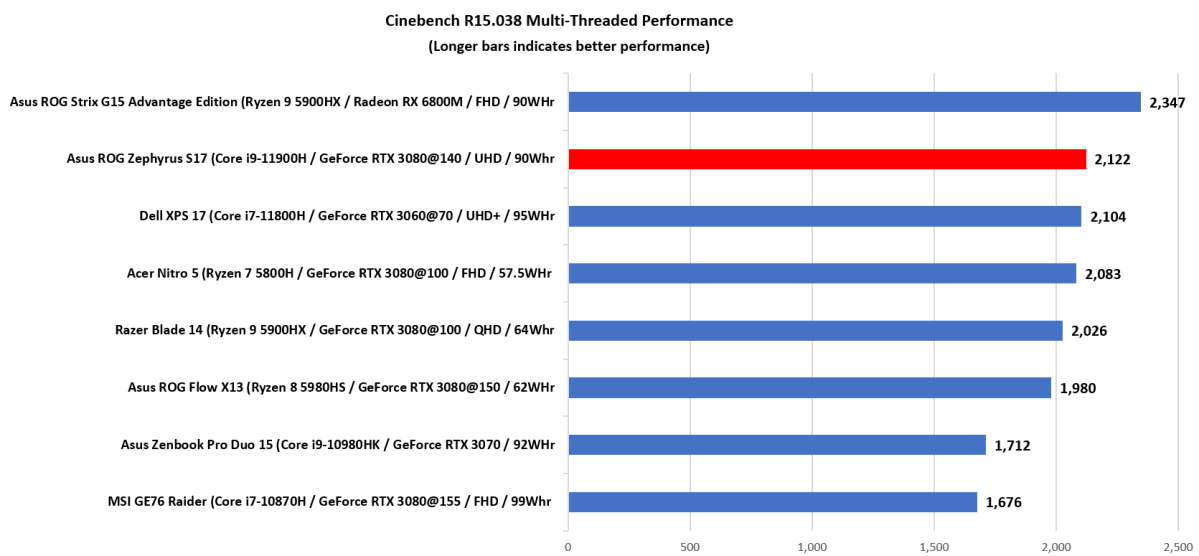
IDG / Dominic Bayley
IDG / Dominic Bayley
IDG / Dominic Bayley
Our Zephyrus S17 proved to be similarly capable in our next benchmark that uses the free HandBrake 0.9.9 utility. This benchmark tests a laptop’s ability to cool before it needs to throttle performance. It involves encoding a 30GB, 1080p MKV file to MP4 using the Android Tablet Preset. The Zephyrus S17 completed the task just shy of the Asus ROG Zephyrus Advantage Edition (a very strong performer), but faster than the rest of our comparisons.
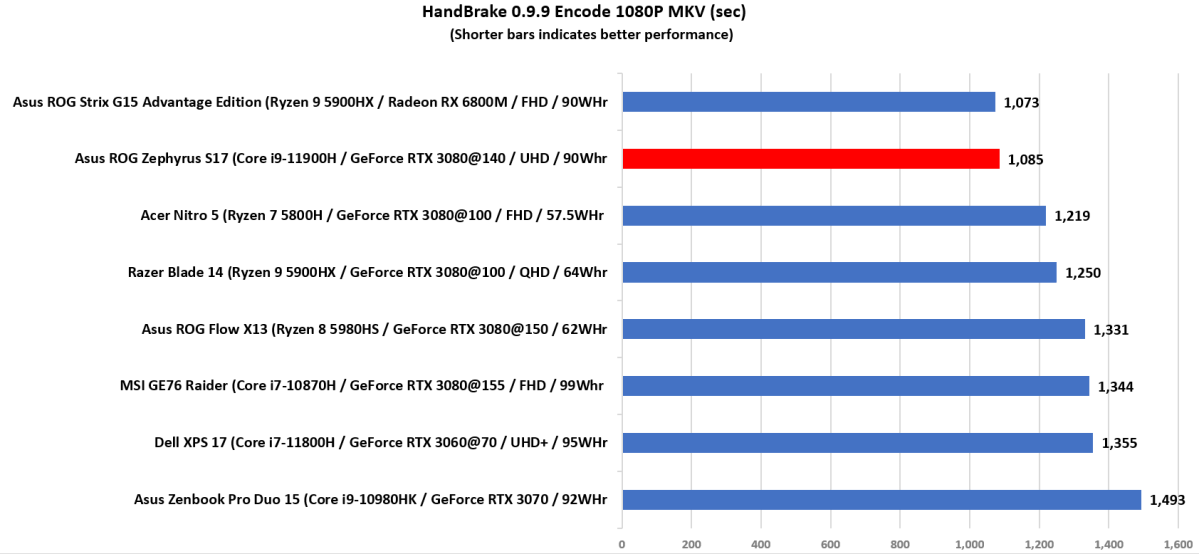
IDG / Dominic Bayley
IDG / Dominic Bayley
IDG / Dominic Bayley
This last result isn’t unexpected. Large laptops like the S17 generally have a performance advantage over smaller units like the 15-inch Acer Nitro 5 and 14-inch Razer Balde 14 since they have more thermal headroom to cool. The S17 also outclassed the larger Dell XPS in this test, proving its superiority over the older 17-inch laptop.
Gaming performance
The results of our gaming benchmarks make no bones about what the ROG Zephyrus is really designed for. It ripped through demanding AAA games with relative ease.
What’s interesting about our gaming benchmark results is that the S17 outperformed other RTX 3080 laptops whose GPUs were set to higher wattages, which is a reminder that higher Total Graphics Power (TGP) doesn’t always equate to better performance in laptops with the same GPUs. We see these differences play out in the graph results below.
In our Rise of the Tomb Raider benchmark, our Asus ROG Zephyrus S17 with Nvidia RTX 3080 GPU set to 140W topped the field, edging out the Asus ROG Zephyrus X13 with Ryzen 8 5980HS CPU and RTX 3080 GPU set at 150W. It also proved superior to the Adata XPG 15KC with GeForce RTX 3070 set at 145W – the combination of the S17’s i9-11900H processor and RTX 3080 GPU making light work of the workload in the RoTTR preset.
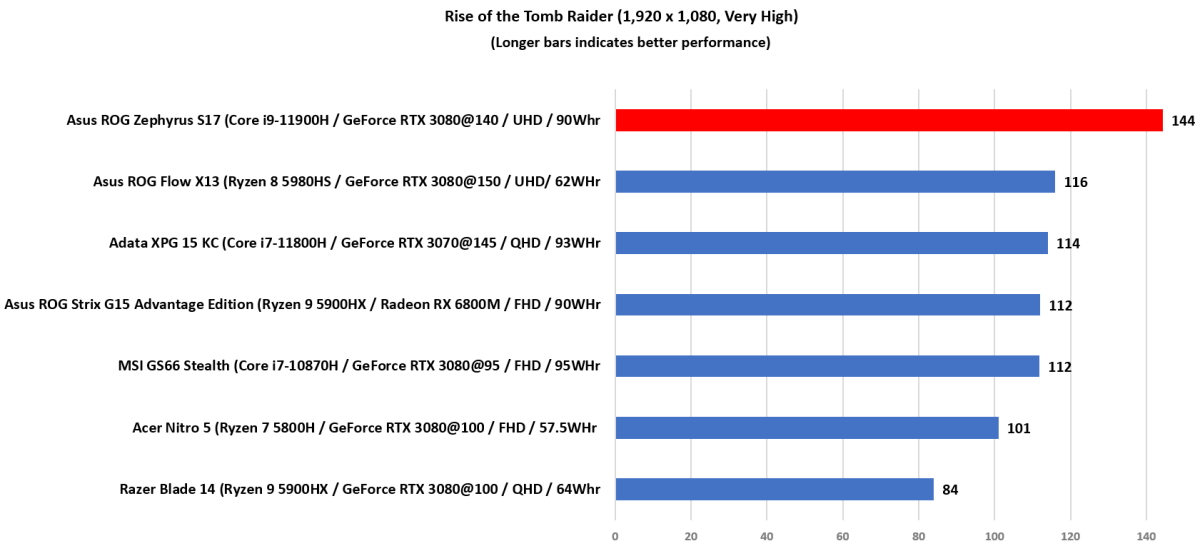
IDG / Dominic Bayley
IDG / Dominic Bayley
IDG / Dominic Bayley
In the Middle Earth Shadow of Mordor 4K benchmark, the results were similarly impressive. Our review unit easily beat our comparison MSI GS66 and Predator Triton 500 comparisons.
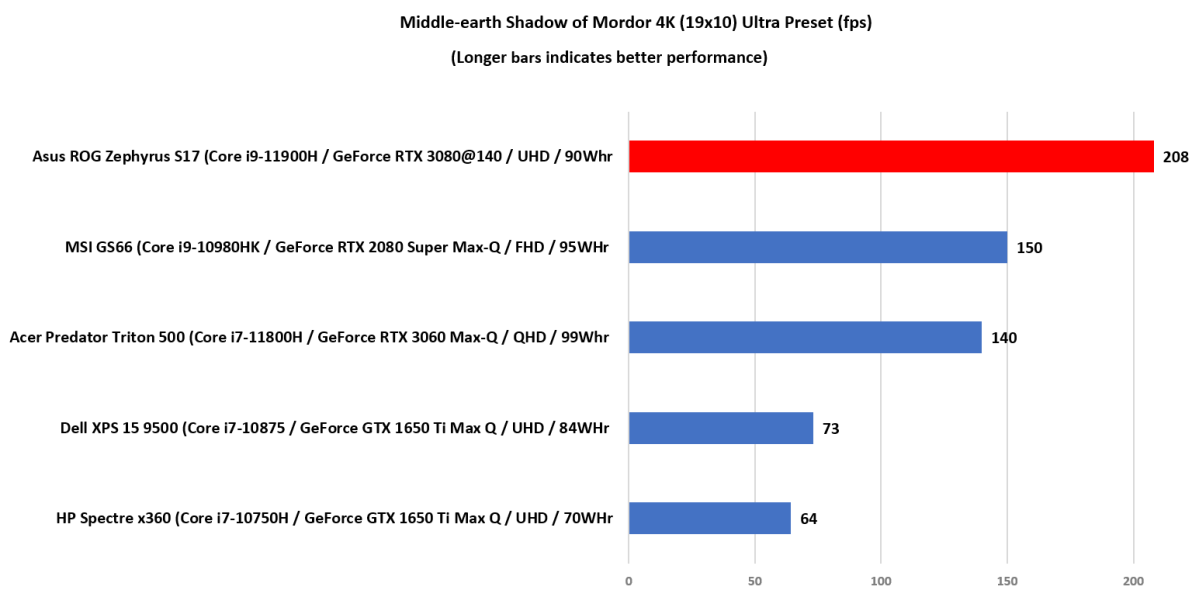
IDG / Dominic Bayley
IDG / Dominic Bayley
IDG / Dominic Bayley
Overall, these two benchmark results bode well for gamers wanting a laptop that’s a cut above in terms of graphics performance, with the high frame rates equating to a smoother gaming experience and more detail in each scene rendered.
It’s worth noting, however, that our 4K review unit lacked Advanced-Optimus (getting by with just Optimus). This feature is present in the other S17 configurations.
Nvidia’s Advanced-Optimus allows the display to bypass the integrated GPU and connect directly with the discrete GPU when a heavy task like a game or 3D editing begins. It’s highly likely this would have given the step-down S17 configuration featuring a WQHD 165Hz display and RTX 3080 with Advanced-Optimus a performance edge over our review unit in our benchmarks had we tested it.
Battery life
The Zephyrus S17 has a large four cell, 90WHr battery. However, it proved to be only a mid-range performer in our battery test that ran its battery down from full to standby mode by playing a 4K video on repeat. Before we launched our test, we charged up the battery to full capacity, unplugged the charging cable, and plugged in a pair of headphones.
The Asus Zephyrus S17 lasted 5 hours and 44 minutes. Although we didn’t get to test the other S17 configurations with Advanced-Optimus, it’s highly likely that they would have outperformed our review unit, possibly benefiting from the power savings that this feature would have afforded them in our lightweight video test.
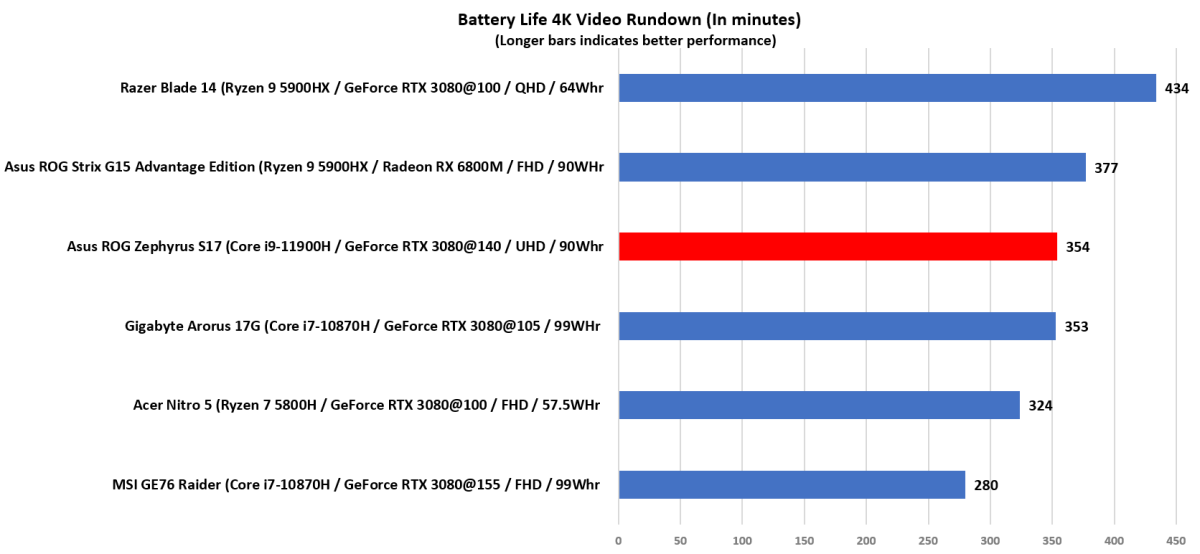
IDG / Dominic Bayley
IDG / Dominic Bayley
IDG / Dominic Bayley
Conclusion
The Asus ROG Zephyrus S17 is one of the most powerful 17-inch gaming laptops you can buy. It excels in CPU and GPU performance and dishes up consistently smooth and detailed visuals in AAA games on its 4K display. The only real downside is the high price. That said, if you’ve got a flexible budget, the Zephyrus is well worth it.
Best Prices Today: Asus ROG Zephyrus S17
RetailerPriceAsus$3699.99View Deal
Author: Dominic Bayley, PCWorld Australia Editor
Based in Australia, Dominic Bayley is a hardcore tech enthusiast. His PCWorld focus is on PC gaming hardware: laptops, mice, headsets and keyboards.
Recent stories by Dominic Bayley:
Dell XPS vs. Inspiron vs. Latitude laptops: Which should you buy?Asus ROG Zephyrus G14 review: Small, thin, and impossibly mightyRazer Blade 14 review: Still Razer’s most versatile gaming laptop




